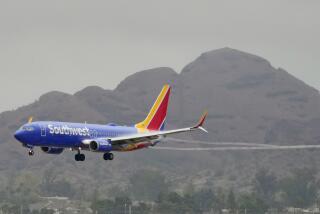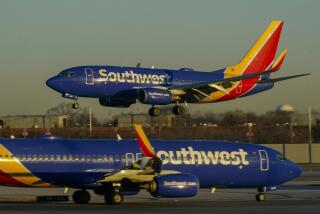Frequent Fliers May Find Less Turbulence Overseas : Trends: It’s getting harder to qualify for free domestic flights, easier to earn foreign freebies.
These are trying times for those who live to fly free.
As airlines around the world create and reshape frequent-flier programs to compete on a worldwide level, the frequent-flying life is getting ever more complicated for American domestic travelers. But in some respects, it’s also getting more attractive for those looking to Europe and other overseas destinations.
To make the best of these developments, says Randy Petersen, Colorado-based publisher of Inside Flyer magazine, “You don’t have to fly more. What you have to do is become a more educated consumer,” taking advantage of the mileage tie-ins increasingly available through telephone companies, credit cards, rental-car companies, hotels and other sources.
Stanley Dale, Arizona-based publisher of the newsletter Mileage & Points, adds this: “For anybody who travels internationally over the next couple of years, (these changes) could be a real plus.”
Here are a few key pieces of the puzzle:
* Increased mileage requirements for free U.S. flights. Having painted themselves into a corner with fare cuts, major carriers are compensating in part by raising the number of frequent-flier miles needed to qualify for a free flight. Beginning Feb. 1, 1995, United Mileage Plus and American AAdvantage program members will need 25,000 miles to get a free domestic coach flight, up from 20,000. USAir’s threshold, too, rises from 20,000 to 25,000 on Jan. 1 next year.
Most of these changes, however, concentrate on the bottom end of benefits, for the moment leaving requirements for international flights unchanged. (Earlier this month, United did announce a mixture of increases and decreases in qualifying mileage levels for international travel.)
Petersen forecasts that the 25,000 figure will become an industry standard. He predicts that Northwest will raise its threshhold from 20,000 to 25,000, too--and that Delta will come down to 25,000 from its current 30,000 level. (Northwest will say only that it is considering “significant changes” in its program in response to “economic realities.”)
As Petersen suggests, alert travelers can neutralize the hike by more efficiently gathering miles from various sources. But some sources could dry up. Many hotel chains have updated programs so that travelers must choose either frequent-flier mileage or frequent-guest points for each stay--but not both. (The prominent exception is Hilton’s HHonors program, which still allows “double-dipping.”)
* Less credit for short trips. On April 1, Northwest’s WorldPerks program will reduce the minimum mileage credit it offers per flight from 750 miles to 500. Thus, a traveler on the 431-mile Northwest route from Dallas to Memphis, will get credit for 500 miles, instead of the current 750. American, United and Continental Airlines made the same move about five years ago. (Throughout 1994, however, Northwest will add 500 bonus miles to the account of anyone connecting through Minneapolis, Detroit or Memphis.) Delta continues to award a minimum of 1,000 miles for each flight, but Petersen and others suggest that will not last.
* Alliances between U.S.-based and foreign-based carriers. “The real growth (of frequent-flier programs) is going to be in the international markets,” says Dale. Throughout Europe, Dale points out, carriers are “starting to come into things. . . . At least in the short term, that’s going to benefit U.S. frequent fliers because of the competition that’s going to surface.”
International cooperative pacts between airlines--agreements that generally allow mileage earned on one airline to be applied toward a flight on another--have been multiplying. American Airlines’ AAdvantage program now includes alliances with Canadian Airlines, Cathay Pacific, Qantas, Singapore and TWA. Northwest’s WorldPerks program includes a partnership with KLM. USAir and British Airways, which have had limited reciprocal arrangements for passengers to “earn and burn” mileage points for several years, took a further step by lifting many restrictions last year.
Meanwhile, United Airlines, which has played an elaborate game of musical partners in recent years (now affiliated with Air Canada, Alitalia, Ansett Australia and Sabena, but disconnected from KLM and Swissair as of December), last month announced an imminent alliance with Lufthansa, bringing together two giants and a massive route system. Under the reciprocal plans, there will be some differences between mileage accrual and redemption possibilities between the airlines.
More information for committed frequent fliers: Susbscriptions to Randy Petersen’s monthly Inside Flyer magazine run $33 a year. For more information, write 4715-C Town Center Drive, Colorado Springs, Colo. 80916; tel. (800) 333-5937. Subscriptions to Stanley Dale’s Mileage & Points, a monthly newsletter, run $17.95 a year. For more information: M&P; Communications, 12629 N. Tatum Blvd., Suite 188, Phoenix, Ariz. 85032; tel. (602) 953-9237.
Reynolds travels anonymously at the newspaper’s expense, accepting no special discounts or subsidized trips.
More to Read
Sign up for The Wild
We’ll help you find the best places to hike, bike and run, as well as the perfect silent spots for meditation and yoga.
You may occasionally receive promotional content from the Los Angeles Times.







